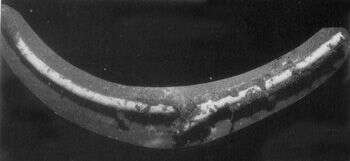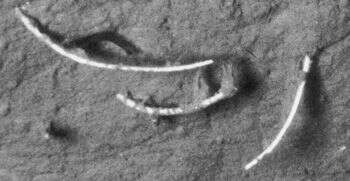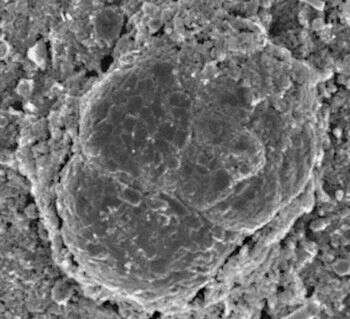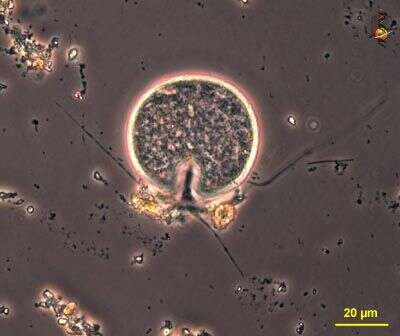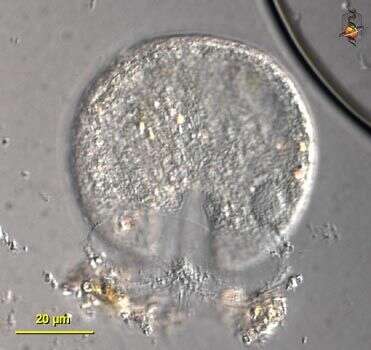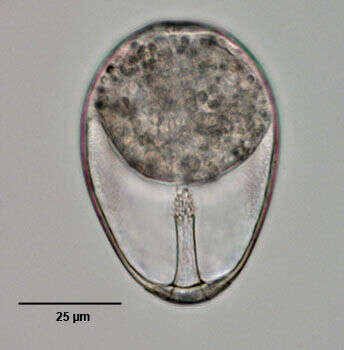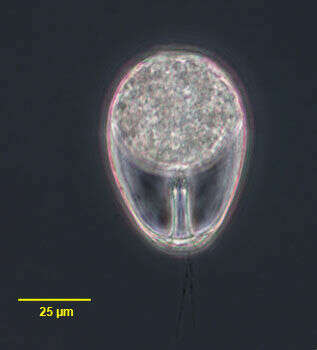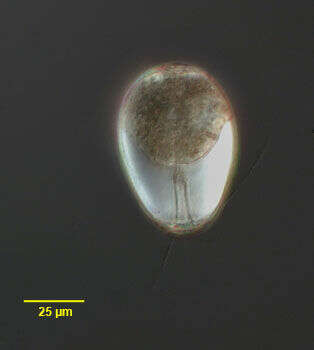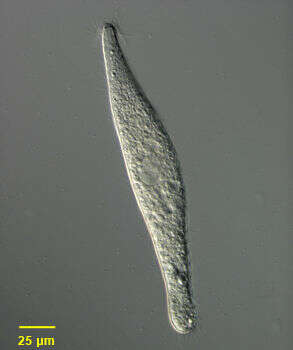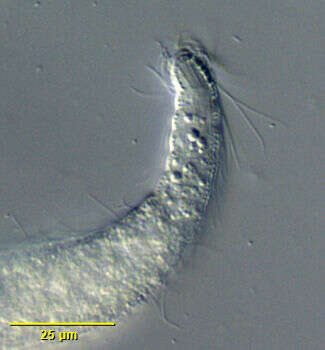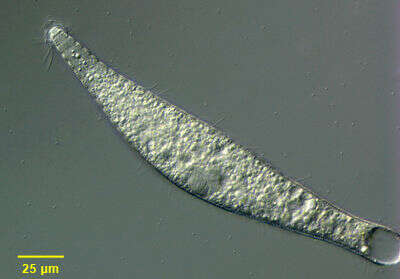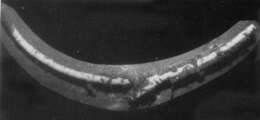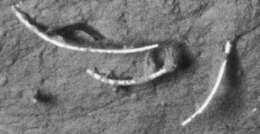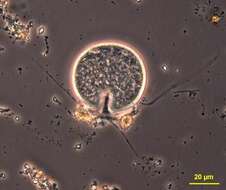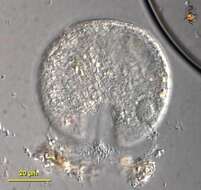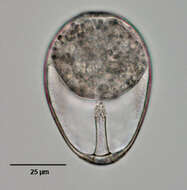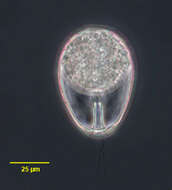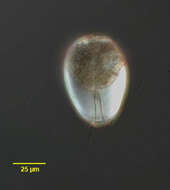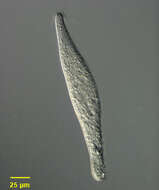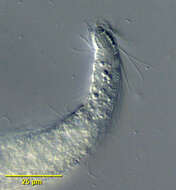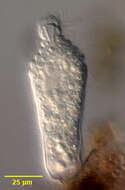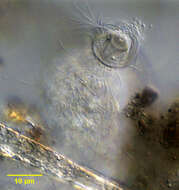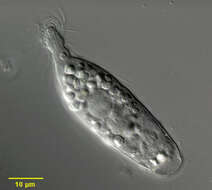-
The white surface of this 6-cm-long foraminiferan is partially hidden by sediment trapped in mucus. The mucus was probably secreted by the polychaete worm Nicolea, which has been found on the test surface and is only about 20% as long as the foram is. Image courtesy of Andrew J. Gooday, Southampton Oceanography Centre. This image first appeared in J. Foram. Res 22:129-146 (1992) and is used with permission.
-
Three individuals photographed on the seafloor, at 850 m. depth, 72 km. NE of Cape Hatteras, North Carolina.Image courtesy of Andrew J. Gooday, Southampton Oceanography Centre. This image first appeared in J. Foram. Res 22:129-146 (1992) and is used with permission.
-
A closeup of a smaller foram (a member of the genus Trochammina) which is living on the surface of the Bathysiphon test. The Trochammina test is 100 microns in diameter. Image courtesy of Andrew J. Gooday, Southampton Oceanography Centre. This image first appeared in J. Foram. Res 22:129-146 (1992) and is used with permission.
-
-
-
-
-
Lagenidiopsis. Amoeba observed in sandy and muddy marine sediments in the vicinity of Broome, Western Australia in September 2003. This image was taken using phase contrast optics. This work was supported by the Australian Biological Resources Study.
-
Lagenidiopsis. Cell observed in sandy and muddy marine sediments in the vicinity of Broome, Western Australia in September 2003. This image was taken using differential interference contrast optics. This work was supported by the Australian Biological Resources Study.
-
Portrait of Lagenidiopsis (species uncertain), a medium-sized shelled marine amoeba of uncertain affinity. The clear ovoid organic shell is slightly flattened and the anterior pseudostome extends into the shell as a tube(seen in this image). The cell body occupies the posterior half of the shell and transmits delicate filose pseudopodia to the exterior through the internal tubular extension of the cell.The filose pseudopodia are seen entering the internal end of the tube in this image. Collected from a commercial saltwater aquarium in Boise, Idaho October 2004. Brightfield illumination.
-
Portrait of Lagenidiopsis (species uncertain), a medium-sized shelled marine amoeba of uncertain affinity. The clear ovoid organic shell is slightly flattened and the anterior pseudostome extends into the shell as a tube. The cell body occupies the posterior half of the shell and transmits delicate filose pseudopodia to the exterior through the internal tubular extension of the cell (seen in this image). Collected from a commercial saltwater aquarium in Boise, Idaho October 2004. Phase contrast illumination.
-
Portrait of Lagenidiopsis, a medium-sized shelled marine amoeba of uncertain affinity. The clear ovoid organic shell is slightly flattened and the anterior pseudostome extends into the shell as a tube. The cell body occupies the posterior half of the shell and transmits delicate filose pseudopodia to the exterior through the internal tubular extension of the cell (seen in this image). Collected from a commercial saltwater aquarium in Boise, Idaho October 2004. DIC.
-
Portrait of extended Lagynus cucumis, a colorless Prostome ciliate found in sapropelic habitats. L. cucumis is synonymous with Lacrymaria cucumis (Penard, 1922) and Lacrymaria putrina (Kahl, 1926). Lagynus cucumis is longer and more slender than L. elegans with about five less pronounced ring-like furrows at the anterior end. The conical head region is much smaller than that of L. elegans. The apical cytostome is supported by fine trichites (seen here). The elongate cell body is flexible, contractile and slightly flattened. Somatic kineties are longitudinal and uniform. Slightly longer cilia surround the anterior end . A bean-shaped macronucleus with a central transverse crease is located in the midportion of the cell (seen well here). There is a single posterior terminal contractile vacuole (not seen in this image). Collected from sapropelic sediments of a freshwater aquaculture tub (pH 7.56) at a Koi farm near Boise, Idaho October 2003. DIC optics.
-
Detail view of anterior end of extended Lagynus cucumis, a colorless Prostome ciliate found in sapropelic habitats. L. cucumis is synonymous with Lacrymaria cucumis (Penard, 1922) and Lacrymaria putrina (Kahl, 1926). Lagynus cucumis is longer and more slender than L. elegans with about five less pronounced ring-like furrows at the anterior end. The conical head region is much smaller than that of L. elegans. The apical cytostome is supported by fine trichites (seen here). The elongate cell body is flexible, contractile and slightly flattened. Somatic kineties are longitudinal and uniform. Slightly longer cilia surround the anterior end. A bean-shaped macronucleus with a central transverse crease is located in the midportion of the cell. There is a single posterior terminal contractile vacuole. Collected from sapropelic sediments of a freshwater aquaculture tub (pH 7.56) at a Koi farm near Boise, Idaho October 2003. DIC.
-
Portrait of extended Lagynus cucumis, a colorless Prostome ciliate found in sapropelic habitats. L. cucumis is synonymous with Lacrymaria cucumis (Penard, 1922) and Lacrymaria putrina (Kahl, 1926). Lagynus cucumis is longer and more slender than L. elegans with about five less pronounced ring-like furrows at the anterior end. The conical head region is much smaller than that of L. elegans. The apical cytostome is supported by fine trichites. The elongate cell body is flexible, contractile and slightly flattened. Somatic kineties are longitudinal and uniform. Slightly longer cilia surround the anterior end. A bean-shaped macronucleus with a central transverse crease is located in the midportion of the cell (seen well here). There is a single posterior terminal contractile vacuole (seen in this image). Collected from sapropelic sediments of a freshwater aquaculture tub (pH 7.56) at a Koi farm near Boise, Idaho October 2003. DIC optics.
-
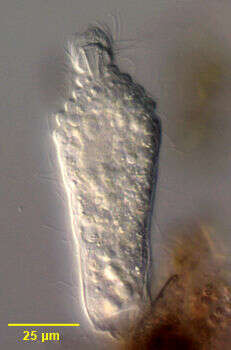
Portrait of contracted Lagynus elegans (Engleman,1862, Quennerstedt,1867), a colorless Prostome ciliate found in sapropelic habitats. The cell body is flask-shaped with a flexible anterior neck marked by concentrically decreasing transverse ciliated furrows (seen well in this contracted individual). A conical head region bears longer cilia and an inconspicuous "dorsal brush" of 3 to 4 groups of kineties between cytopharyngeal nematodesmata (seen well here) and the first perioral ciliary ring. This feature distinguishes Lagynus from Lacrymaria, which has a short longitudinal dorsal brush of cilia on the neck region. Somatic kineties are longitudinal. The silverline system of Lagynus is also different from that of Lacrymaria. The neck region of Lagynus elegans is much less extensible (about 1/3 body length) than that of Lacrymaria olor. The posterior is often flattened. There is a single ellipsoid macronucleus and adjacent micronucleus about mid-body. There is a large posterior terminal contractile vacuole. Multiple food vacuoles are scattered through the cytoplasm. The cytoplasm L. elegans, like that of some other anaerobic ciliates, contains methanogenic bacilli and hydrogenosomes. L. elegans feeds on ciliates, cyanobacteria and other bacteria. Collected from sapropelic sediments of a freshwater aquaculture tub (pH 7.56) at a Koi farm near Boise, Idaho October 2003. DIC optics.
-

Detail view of anterior end of Lagynus elegans (Engleman,1862, Quennerstedt,1867), a colorless Prostome ciliate found in sapropelic habitats. The cell body is flask-shaped with a flexible anterior neck marked by concentrically decreasing transverse ciliary furrows. A conical head region bears longer cilia and an inconspicuous "dorsal brush" of 3 to 4 groups of kineties between cytopharyngeal nematodesmata (seen well here) and the first perioral ciliary ring. This feature distinguishes Lagynus from Lacrymaria, which has a short longitudinal dorsal brush of cilia on the neck region. Somatic kineties are longitudinal. The silverline system of Lagynus is also different from that of Lacrymaria. The neck region of Lagynus elegans is much less extensible (about 1/3 body length) than that of Lacrymaria olor. The posterior is often flattened. There is a single ellipsoid macronucleus and adjacent micronucleus about mid-body. There is a large posterior terminal contractile vacuole. Multiple food vacuoles are scattered through the cytoplasm. The cytoplasm L. elegans, like that of some other anaerobic ciliates, contains methanogenic bacilli (seen well in this image) and hydrogenosomes. L. elegans feeds on ciliates, cyanobacteria and other bacteria. Collected from sapropelic sediments of a freshwater aquaculture tub (pH 7.56) at a Koi farm near Boise, Idaho October 2003. DIC optics.
-
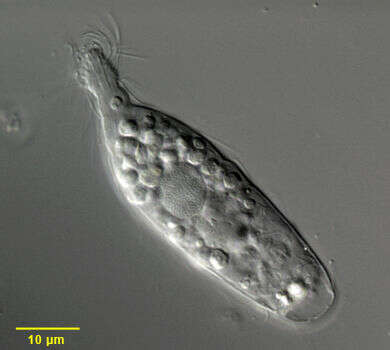
Portrait of extended Lagynus elegans (Engleman, 1862, Quennerstedt,1867), a colorless Prostome ciliate found in sapropelic habitats. The cell body is flask-shaped with a flexible anterior neck marked by concentrically decreasing transverse ciliated furrows. A conical head region bears longer cilia and an inconspicuous "dorsal brush" of 3 to 4 groups of kineties between cytopharyngeal nematodesmata (seen well here) and the first perioral ciliary ring. This feature distinguishes Lagynus from Lacrymaria, which has a short longitudinal dorsal brush of cilia on the neck region. Somatic kineties are longitudinal. The silverline system of Lagynus is also different from that of Lacrymaria. The neck region of Lagynus elegans is much less extensible (about 1/3 body length) than that of Lacrymaria olor. The posterior is often flattened. There is a single ellipsoid macronucleus and adjacent micronucleus about mid-body. There is a large posterior terminal contractile vacuole. Multiple food vacuoles are scattered through the cytoplasm. The cytoplasm L. elegans, like that of some other anaerobic ciliates, contains methanogenic bacilli and hydrogenosomes. L. elegans feeds on ciliates, cyanobacteria and other bacteria. Collected from sapropelic sediments of a freshwater aquaculture tub (pH 7.56) at a Koi farm near Boise, Idaho October 2003. DIC optics.


